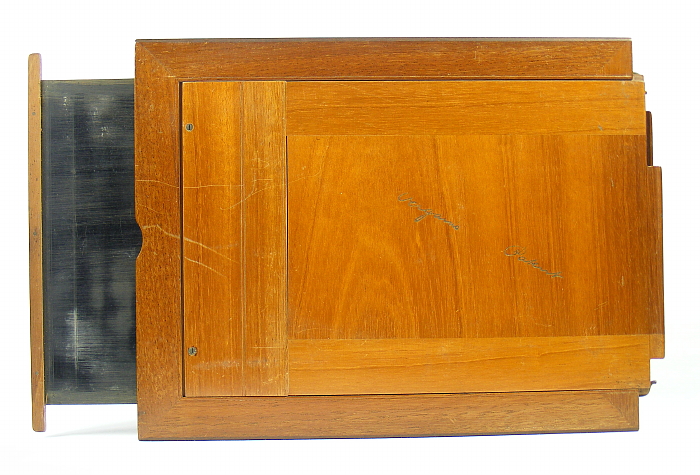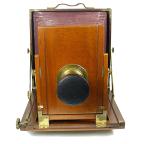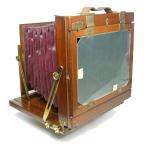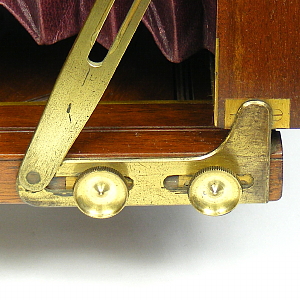Treble Patent Camera
McKellen, S. D.
| Name: | Treble Patent Camera |
| Type: | Field Camera |
| Manufacturer: | McKellen, S. D. |
| Country of Origin: | United Kingdom (Manchester) |
| Construction: | Field camera of conventional construction of mahogany and brass, but incorporating a number of key features covered by the patents that give it its name. |
| Production Period: | Unknown |
| Plate / Film Size: | Whole plate |
| Lens: | Dallmeyer Rapid Rectilinear (see notes) |
| Shutter: | None |
| Movements: | Reversible and tilting back with limited horizontal swing; rising and tilting front |
| Dimensions (w x h x l): | |
| Date of this Example: | c1896 |
| Serial Number: | No serial found on the camera body. |
| Availability: |
|
| Inventory Number: | 378 |
|
Photos copyright © 2013 David Purcell. Do not use without permission. |
Description
Lovely example of McKellen's Treble Patent Camera in whole plate size, with red bellows that are in excellent condition and mahogany and brass that have not been tampered with! It has a clear name plate with an address of "18 Brown Street". According to 'British Camera Makers' [2] this address was used from 1885 to 1887, and was then listed jointly with another address in Manchester into the 1890s. The camera is likely to date to the earlier period.
The treble patents referred to in the name relate to the following design features that are present on this camera:
 |
|
 |
A solid ring type of integral turntable fitted into the baseboard (patent #319). This is the early design. Later the tripod leg mountings formed part of the brass ring, and the wooden insert was one solid piece. |
 |
|
 |
The lens board is able to pivot allowing it to swing forward and down to rest inside the baseboard whilst the front standard itself swings backwards when collapsing the camera. On early examples such as this one, the front standard is fixed to the front edge of the focusing frame by two hinges. This principle was widely used on other cameras, albeit with variations to the details of the design. |
 |
|
 |
Double rack and pinion focussing adjustment acting on the inner frame, allowing lenses of different focal lengths to be used. The front pinion extends the bellows, allowing longer focal length lenses to be used. The rear pinion allows the front to be racked back closer to the rear section, allowing the use of wide angle lenses. |
While these three features and corresponding patents led to the camera bearing the name "Treble Patent", in fact the design incorporated a number of other patents over its period of production. According to McKeown [1] McKellen listed eight different patents against this camera!
The group of photos below show some of the other features of the camera:
|
The photo at top left shows the large hinge found on the early cameras. The catch immediately above has to be released to allow the lens board to swing free of the uprights when folding the camera. There is second similar catch on the opposite side of the lens board.
The photo at top right shows a sprung catch that has to be lifted to allow the double extension to be used. According to the Early Photography web site, this was later replaced by a fixed stop that prevented the inner frame from being cranked out beyond the double extension limit.
The bottom left image shows the slotted adjustment that provides some degree of horizontal swing.
The camera came with 5 bookform dark slides, all of which are inscribed "Vegaris Patent". These are quite unusual as this design was intended for use with sheet film. A single length of film was wrapped around the central partition (the black insert that can be seen in the photo below) to allow two exposures.

Notes
According to McKeown [1] the lens should be a Dallmeyer R.R. with waterhouse stops. A replacement was bought at Photographica (May 2006) from a dealer and came with one stop and a leather lens cover. It is marked for 8½ x 6½ and it fits the camera, though not perfectly. A good image is formed on the screen and it appears to be a good match. The lens carries a patent date of June 30th 1868 (US) and serial #38069, which according to the Lens Vade Mecum [10] dates it to 1885, which would make it at least contemporary to the camera.
![[ ]](../../images/unchecked.png)
![[x]](../../images/checked.png)












